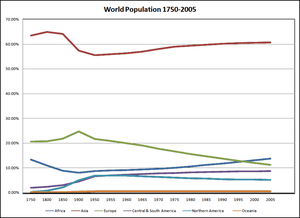Historical demography

Historical demography is the quantitative study of human population in the past. It is concerned with population size, with the three basic components of population change--fertility, mortality, and migration, and with population characteristics related to those components, such as marriage, socioeconomic status, and the configuration of families.
Sources
The sources of historical demography vary according to the period and topics of the study.
For the recent period - beginning in the early nineteenth century in most European countries, and later in the rest of the world - historical demographers make use of data collected by governments, including censuses and vital statistics.[1]
In the early modern period, historical demographers rely heavily on ecclesiastical records of baptisms, marriages, and burials, using methods developed by French historian Louis Henry, as well as hearth and poll tax records.
For population size, sources can also include the size of cities and towns, the size and density of smaller settlements, relying on field survey techniques, the presence or absence of agriculture on marginal land, and inferences from historical records. For population health and life expectancy, paleodemography, based on the study of skeletal remains, is another important approach for populations that precede the modern era, as is the study of ages of death recorded on funerary monuments.
History
Historical analysis has played a central role in the study of population, from Thomas Malthus in the eighteenth century to major twentieth-century demographers such as Ansley Coale and Samuel H. Preston. The French historian Louis Henry (1911-1991) is widely credited with the development of historical demography as a distinct subfield of demography.[2] In recent years, new research in historical demography has proliferated owing to the development of massive new population data collections, including the Demographic Data Base in Umeå, Sweden,[3] the Historical Sample of the Netherlands,[4] and the Integrated Public Use Microdata Series (IPUMS).
Historical population of the world

.png)
During the period from 500 to 900 AD world population grew slowly but the growth rate accelerated between 900 and 1300 AD when the population doubled.[citation needed] During the 14th century, there was a fall in population associated with the Black Death that spread from Asia to Europe. This was followed by a period of restrained growth until the 18th century when world population entered a period of accelerated growth again. As previously the acceleration was more marked in the European population, due to the scientific revolution and resulting inventions lowering the childbirth mortality rate.[1] European population reached a peak growth rate of 10 per thousand per year in the second half of the 19th century.[citation needed]
During the 20th century, the growth rate among the European populations fell and was overtaken by a rapid acceleration in the growth rate in other continents, which reached 21 per thousand per year in the last 50 years of the millennium. Between 1900 and 2000 CE the population of the world increased by 277%, a fourfold increase from 1.5 billion to 6 billion. The European component increased by 124%, and the remainder by 349%.[1]
See also
- Demography
- Paleodemography
- Prehistoric demography
- Classical demography
- Medieval demography
- Demographic Transition
- World population
- Population history of American indigenous peoples
- Historical demography of Poland
- Population reconstruction
References
- ↑ 1.0 1.1 1.2 Historical Demography in Encyclopedia of Public Health, Retrieved on 3 May 2005
- ↑ Paul-André Rosental, The Novelty of an Old Genre: Louis Henry and the Founding of Historical Demography, Population (English edition), Volume 58 –2003/1, Retrieved on 3 May 2007
- ↑ http://www.ddb.umu.se/index_eng.html, Retrieved on 3 June 2009
- ↑ http://www.iisg.nl/hsn/, Retrieved on 3 June 2009
Further reading
- Fogel, Robert W. The Escape from Hunger and Premature Death, 1700-2100: Europe, America, and the Third World (2004)
- Glass, David V. and David E.C. Eversley, Population in History: Essays in Historical Demography, London: Edward E. Arnold, 1965
- Livi Bacci, Massimo et al. Population and Nutrition: An Essay on European Demographic History (Cambridge Studies in Population, Economy and Society in Past Time) (1991).
- Stangl, Günter, Antike Populationen in Zahlen. Überprüfungsmöglichkeiten von demographischen Zahlenangaben in antiken Texten (Frankfurt am Main u.a., Peter Lang, 2008) (Grazer Altertumskundliche Studien, 11).
- Walter, John W. and Roger Schofield, eds. Famine, Disease and the Social Order in Early Modern Society (1991)
- Willigan, J. Dennis, and Katherine A. Lynch, Sources and Methods of Historical Demography, New York: Academic Press, 1982.
- Wrigely, E. A., ed. An Introduction to English Historical Demography, London: Weidenfeld & Nicholson, 1966.
- Wrigely, E. A., and R. S. Schofield. The Population History of England 1541-1871 (1989)
- Wrigely, E. A., et al. English Population History from Family Reconstitution 1580-1837 (1997)
External links
- International Commission for Historical Demography
- H-Demog, an international scholarly online discussion list on demographic history
- POPULATION STATISTICS in historical perspective